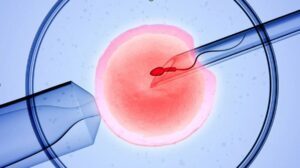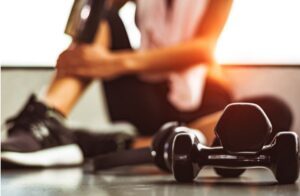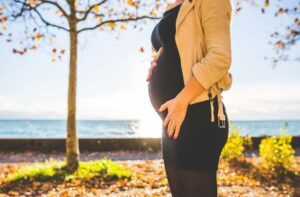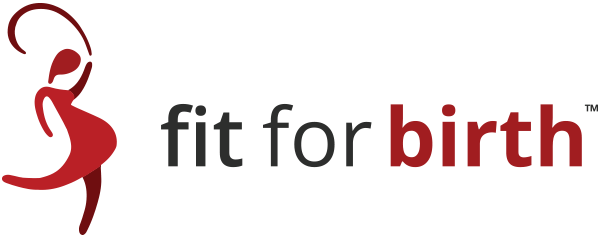Last updated: 9/17/23
A Fit For Birth’s Holistic Fertility & Pregnancy Safe Coach asked:
“I would love to know more about IVF pregnancies!
I’ve had two clients now who conceived this way and so are more conservative with what they’re willing to do [in exercise] and I don’t know how much is legitimate and how much is just fear.”
This article answers this question in the following outline:
- Quick look at ART & IVF treatments, as well as Infertility rates
- 8 Steps to how IVF is performed
- Scientific Studies answering: Does Fitness/Exercise help or hurt one’s chances of successful IVF?
→ The short answer is that exercising both prior to, during, and after IVF treatment appears to help one’s chances of successful pregnancy. However, each person is unique and a person’s foundational lifestyle habits should be considered.

Quick-look at ART & IVF Treatments, with Infertility Rates
Infertility is technically defined as the inability for a couple to conceive a pregnancy after 12 months of unprotected intercourse. Rates in various locations of the world are:
- United States: 1 in 5 (19%)
- United Kingdom: 1 in 7 (14%)
- Australia: 1 in 6 (15%)
- Canada: 1 in 6 (16%)
These rates have been steadily worsening for several decades. For example, in the U.S. just a few years ago, the rate was closer to 10 or 12 percent. So, it is understandable that many of you, or your clients, will be seeking guidance on how to achieve a healthy pregnancy. Check out 5 Ways to Naturally Boost Your Fertility here. To be sure, this is an issue that affects both females and males equally, with factors like poor sperm quality being equally as common as any “female-related” factor.
But for those who are already at the point of seeking assisted reproductive technology (ART), here are some basic stats to understand. ART encompasses a broader range of fertility treatments and technologies. In vitro fertilization (IVF) is often one of the main components of ART. We will explain the 8 basic steps of IVF in just a bit.
Intercourse naturally provides women in their mid-20’s with a 25-30% of getting pregnant every month. Fertility generally starts to fall in their early 30s, and more so after age 35 (into the 15-20% range). By the age of 40, the likelihood of achieving pregnancy during any given monthly cycle is approximately 5%.

In contrast, IVF treatments dramatically improve those aging odds. Here is a comparison chart to help clarify:
|
Age |
Intercourse | IVF in Australia | IVF in America |
|
Mid-20s |
25-30% |
||
|
Early 30s |
20% |
30-34: 43% |
|
|
35 |
15% |
35-39: 31% |
35: 41.5% 35-37: 31.9% |
| 40 | 5% | 40-44: 11% |
38-40: 22.1% 41-42: 12.4% 43-44: 5% 44: 1% |
In addition, doing multiple cycles of IVF can really increase one’s chances of pregnancy. Check out this table for comparison:
|
Age Range |
Chances of Conception using IVF |
|
21-24 |
56.8% after six cycles; 70.8% after 12 cycles |
|
25-27 |
59% after six cycles; 79.3% after 12 cycles |
|
28-30 |
62% after six cycles; 77.9% after 12 cycles |
|
31-33 |
60.7% after six cycles; 76.6% after 12 cycles |
| 34-36 |
55.9% after six cycles; 74.8% after 12 cycles |
| 37-39 |
46.3% after six cycles; 67.4% after 12 cycles |
| 40-45 |
27.6% after six cycles; 55.5% after 12 cycles |

The 8 Steps of IVF
Here is a basic overview of IVF, so that you or your client can have an idea of what to expect:
- Medications & Hormones are used to stimulate a woman’s ovaries to produce multiple eggs.
- Blood tests & ultrasounds are used to monitor follicle development and the thickness of the uterine lining. (Follicles serve as protective structures for eggs.)
- Collect the eggs: When the follicles are deemed mature, a needle is inserted through the vaginal wall and into the ovaries to collect the mature eggs.
- Collect the sperm: On the same day as the egg retrieval, sperm is collected from the male partner or a sperm donor.
- Mix eggs with sperm: In a laboratory setting, the collected eggs and sperm are combined in a dish for fertilization. This can be done through conventional insemination (placing sperm near the eggs) or intracytoplasmic sperm injection (ICSI), where a single sperm is injected directly into an egg.
- “Grow” the fertilized eggs for a few days: The fertilized eggs, now called embryos, are cultured in a controlled environment for several days, usually up to five or six days. During this time, the embryos are monitored for their development and quality. The cultured environment is designed to mimic the conditions of the uterus to support the embryo’s growth and development during the early stages of pregnancy.
- Place the fertilized eggs into the woman’s uterus: After the embryos have developed, one or more of the best-quality embryos are selected for transfer into the woman’s uterus. The number of embryos transferred depends on various factors, including the woman’s age and medical history.
- Cross your fingers: After the embryo transfer, there is a waiting time of about two weeks to see if the procedure was successful. During this time, the woman may continue taking hormone medications to support the uterine lining and early pregnancy. A blood test is performed to measure the levels of human chorionic gonadotropin (hCG), a hormone produced by the developing embryo. Elevated hCG levels indicate a successful pregnancy.

There are other variations within and around ART & IVF as well. Here is an example of the way a fertility clinic may describe the various options:
- IVF + Intracytoplasmic Sperm Injection (ICSI) – ICSI is employed to directly inject a single, healthy sperm into an egg to facilitate fertilization. This is typically done when there are concerns about the sperm’s ability to fertilize the egg naturally
- IVF + Sperm or Egg donor
- IVF + Frozen Embryo Transfer (FET) – Embryo freezing allows for the preservation of viable embryos for future use.
- IVF + Elective Single Embryo Transfer (eSET) – The primary goal of eSET is to reduce the risk of multiple pregnancies, by transferring a single, carefully selected embryo into the woman’s uterus during an IVF cycle.
- Mini IVF (minimal stimulation) – Involves using lower doses of fertility medications to stimulate the ovaries and retrieve fewer eggs compared to traditional IVF. The primary goal of Mini IVF is to reduce the cost, discomfort, and potential risks associated with the high doses of medications used in conventional IVF.
- Natural IVF (Natural Cycle IVF / Minimal Stimulation IVF) – Unlike conventional IVF, where a woman’s ovaries are stimulated with hormonal medications to produce multiple eggs, natural IVF involves retrieving and fertilizing the one egg naturally produced during her menstrual cycle.
A 2002 study found that “Natural cycle IVF is a low-risk and patient-friendly procedure with an ongoing pregnancy rate of about 7% per started cycle.”

Does Fitness/Exercise help or hurt one’s chances of successful IVF?
These three scientific studies intended to discover whether or not IVF outcomes would be affected by exercise prior to IVF. Here are the takeaways:
1. No difference in IVF outcomes, but questionable additional findings: A 2004 study in Fertility and Sterility is perhaps one of the reasons why some were originally nervous about exercise during IVF. The study asked 2567 women to report their exercise habits. Of those, 1588 regularly exercised an average of 4.3 hours per week, (although the range was anywhere from 1 to 40 hours). The other 979 did not exercise. Researchers found that there was no difference in IVF outcomes. Fine, but they also observed that “women who had been exercising regularly for 1–5 years were at greater risk for failure of cycle stimulation, failure of implantation, and failure of development of a live birth after a chemical pregnancy.” Furthermore, those with more than 10 years of regular exercise were at an even more elevated risk of cycle stimulation failure. So, this wasn’t looking good for exercise back in 2004, but read the next two studies to get a better picture.
2. Cardio associated with higher chance of live birth: A 2016 study in Reproductive BioMedicine Online also sought to determine if exercise prior to IVF would have an effect, this time in 273 women who underwent 427 IVF cycles. Researchers found that an average of 2.8 hours of weekly moderate to vigorous exercise “is unlikely to have a deleterious effect on IVF success.” Even more, they actually found that there was a difference depending which activities were participated, saying, “greater time spent in aerobics, rowing, and on the ski or stair machine was associated with higher probability of live birth.”
3. Analysis of prior studies confirms that exercise prior to IVF is associated with increased rates of pregnancy and birth: A 2018 systematic review and meta-analysis in Reproductive Biology and Endocrinology also looked at maternal physical activity prior to IVF and ICSI cycles, poised to summarize the overall findings of 8 previously published studies. Of the 3683 infertile couples undergoing treatment, researchers concluded, “Female physical activity before IVF/ICSI cycles was associated with increased rates of clinical pregnancy and live births.”
→So, the take-home message is that having a regular habit of physical exercise prior to commencing IVF treatments will increase a person’s chance of having a baby!
But what about exercising during IVF treatments?
These two studies set out to determine if IVF treatments would be affected if a woman exercises during IVF. Here are the takeaways:
1. Low and moderate physical exercise increases implantation and live birth rates: A 2010 study in Reproductive BioMedicine Online starts us off with a bang. Participants were 131 women who were undergoing their first IVF treatment cycle. One of the first things found in this study was that women tended to decrease their activity level during their IVF treatment period. Check this chart to see how participants in this study adjusted their usual habits:
| Activity Level | Prior to IVF Treatment | During IVF Treatment |
| Low | 17 | 68
(Formerly high and moderate exercisers moved themselves into this lower category of exercise.) |
| Moderate | 99 | 63 |
| High | 15 | 0 |
In this study, the women decided to decrease their activity levels on their own, they were not advised to do so. In other words, it felt either natural—or possibly fearful—enough to make this change, even though they were not advised to do so.
The big conclusion, however, to this 2010 study was that more physical activity equated to an increased chance of having a baby: “The women who were physically more active during treatment were more likely to have increased implantation rates and live birth results.”
The low physical activity group had 22.1% live birth rate per retrieval, compared to the moderate physical activity group that experienced a 47.6% rate.
Researchers discussed that reasons for this likely had to do with stress management, stating, “Maternal stress following embryo transfer decreases immediately when the subject goes back to routine daily activities.” Additional discussion included:
- Positive effects of physical activity on stress and anxiety reduction, as well depression coping.
- Women who preferred to be more physically active may have felt more positive emotions of confidence and reduced stress, having a beneficial impact on their likelihood of achieving conception.
- The beneficial effect that lowering stress has on the number of eggs able to be retrieved and fertilized.
This 2010 study went on to acknowledge that despite these results, “Most fertility centres advise some kind of restriction of physical activity in the patient’s daily life after embryo transfer.” Researchers of this study called this practice “unfounded” and suggested instead, “that clinicians should encourage patients to keep on their routine daily physical activity levels.”
2. Implementing exercise during IVF treatments is beneficial for gestational diabetes and preeclampsia: A 2019 study in Research Quarterly for Exercise and Sport specifically looked at exercise during IVF treatments for 170 women with gestational diabetes. Their conclusions reinforced previous research, stating, “Implementing the physical activity program by IVF-women during pregnancy is an effective intervention strategy in reducing the risk of adverse maternal and fetal outcomes.” Not only did diabetes significantly lower, but so did preeclampsia. This study included these variety of exercise modes:
- Walking
- Aerobic
- Strength-conditioning
- Relaxation exercises

CONCLUSION – How might Foundational Lifestyle Choices Impact IVF?
The evidence here suggests that healthy movement—before, during, and after IVF treatment—will continue to bolster health.
At Fit For Birth, we teach our clients to get in touch with their minds and bodies. Whether or not you or your client chooses to exercise during an IVF treatment is a personal choice, and there can be a myriad of factors influencing her feelings to do so (or not). The studies presented here demonstrate that exercise is beneficial both before and during IVF treatments.
But what kind of exercise, and for how long? Some of those answers can be gleaned in the research notes above, but it really needs to be based on the unique individual. Someone who reports stress levels at a “3 of 10” will be able to handle exercise completely differently than someone who reports a level “8 of 10”. Someone who eats healthfully, including anti-inflammatory foods, will be able to recover from exercise entirely differently than someone who does not eat well. Someone who sleeps 8 hours, and soundly through the night, will tolerate exercise in a very different manner than someone who does not sleep well. And there are additional powerful factors, including breathing habits, exposure to environmental toxins, and more. All these factors make a person unique.
Remember, exercise is like a prescription drug. It alters hormones and chemistry in profound ways, yes typically for the better. But the frequency, duration, and type must be aligned to what fits the individual. Let’s not make it too much, nor too little, but let’s get it just right.
James Goodlatte is a Father, Holistic Health Coach, Corrective Exercise Practitioner, Speaker, Author, Professional Educator, and the founder of Fit For Birth. In 2008, He found out he would be a father and immediately shifted his passion for holistic wellness and fitness to his family. Today, he is a driving force in providing Continuing Education Credits for the pre and postnatal world, with Fit For Birth professionals in over 50 countries. James is also the program director for Fit For Birth pre & postnatal personal training worldwide, and is a contributing member of the First 1000 Days Initiative at the Global Wellness Institute.
REFERENCES
IMAGE: Healthline. https://www.healthline.com/health-news/children-born-via-ivf-face-higher-health-risks
Retrieved 2023 from https://www.cdc.gov/reproductivehealth/infertility/index.htm
Retrieved 2023 from http://www.nhs.uk/conditions/Infertility/Pages/Introduction.aspx
Retrieved 2023 from http://www.myvmc.com/diseases/infertility/
Retrieved 2023 from http://healthycanadians.gc.ca/healthy-living-vie-saine/pregnancy-grossesse/fertility-fertilite/fert-eng.php
- Health News Team. Fertility after 35: Your questions, answered. SHARP. Retrieved 9/2/23 from https://www.sharp.com/health-news/fertility-after-35-your-questions-answered
(2021) AGE and Fertility. Better Health Channel. Retrieved 9/12/23 from https://www.betterhealth.vic.gov.au/health/conditionsandtreatments/age-and-fertility
- Robbins, Tony. Lifeforce. Simon & Schuster. p.375
IMAGE: IVI Care. https://ivi-fertility.com/blog/cycles-ivf-pregnant/
AGE and Fertility. Better Health Channel. Retrieved 9/12/23 from https://www.betterhealth.vic.gov.au/health/conditionsandtreatments/age-and-fertility
ACOG. Female Age-Related Fertility Decline. Retrieved 9/12/23 from https://www.acog.org/clinical/clinical-guidance/committee-opinion/articles/2014/03/female-age-related-fertility-decline
Conti, Jenn MD. Age and fertility: What are your chances of pregnancy by age? RO Health Guide. Retrieved 9/12/23 from https://ro.co/health-guide/chance-of-pregnancy-by-age/
IMAGE: Cleveland Clinic. https://health.clevelandclinic.org/iui-vs-ivf/
IMAGE: The Conversation. https://theconversation.com/standard-ivf-is-fine-for-most-people-so-why-are-so-many-offered-an-expensive-sperm-injection-they-dont-need-158227
(n.d.) Kinds of IVF. Morgan Fertility and Reproductive Medicine. Retrieved 9/12/23 from https://morganfertility.com/kinds-of-ivf/
- Pelinck, et al. Human Reproduction Update. Efficacy of natural cycle IVF: a review of the literature. Retrieved 9/12/23 from https://academic.oup.com/humupd/article/8/2/129/624657 (PDF)
IMAGE: https://www.newhopefertility.com/blog/the-dos-and-donts-of-exercise-during-ivf/
- Morris, et al. Effects of exercise on in vitro fertilization (IVF) outcomes. Fertility and Sterility. Retrieved 9/12/23 from https://doi.org/10.1016/j.fertnstert.2004.07.330
- Gaskins, et al. Maternal physical and sedentary activities in relation to reproductive outcomes following IVF. Reproductive BioMedicine Online. Retrieved 9/12/23 from https://www.sciencedirect.com/science/article/abs/pii/S1472648316304060
- Rao, et al. Maternal physical activity before IVF/ICSI cycles improves clinical pregnancy rate and live birth rate: a systematic review and meta-analysis. Reproductive Biology and Endocrinology. Retrieved 9/12/23 from https://link.springer.com/article/10.1186/s12958-018-0328-z
- Kucuk, et al. Effect of energy expenditure and physical activity on the outcomes of assisted reproduction treatment. Reproductive BioMedicine Online. Retrieved 9/12/23 from https://www.sciencedirect.com/science/article/abs/pii/S1472648309002247
- Charkamyani, et al. Reducing the Adverse Maternal and Fetal Outcomes in IVF Women by Exercise Interventions During Pregnancy. Research Quarterly for Exercise and Sport. Retrieved 9/12/23 from https://www.tandfonline.com/doi/abs/10.1080/02701367.2019.1639601
IMAGE: https://flowingzen.com/16-guidelines-for-practicing-qigong-while-pregnant/
